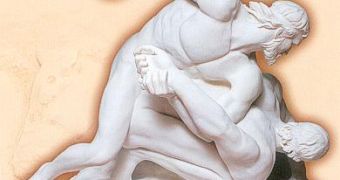The drive of getting over your opponents is as old as humankind. Power, a higher rank in the hierarchy, is strongly motivating the human males.
"Whether it is in combat, business, sports, or even marriage, trying to gain an advantage is a no-brainer. It is an innate human trait," said Charles Yesalis, an expert on performance-enhancing drugs at Pennsylvania State University. That's why everything is worth trying, including cheating nature by means of doping, to reach this goal. And this could explain performances in aging athletes.
"However, in olden times turning to chemical enhancement wasn't controversial-it was a given," he added.
In Maya civilization, people chewed cocoa leaves (from which cocaine is extracted) to improve performance in their violent and sometimes deadly ball game "Pok-a-tok."
"Cocoa leaves are known to delay fatigue and increase strength," Yesalis said.
3,000 years ago ancient Greek Olympians used mushroom and herb concoctions to boost their energies and they even appealed to an "organotherapy" diet to gain strength.
"They might eat the testicles of a man or animal to gain potency, or the heart to gain bravery," Yesalis explained. "The official prize at the Olympic games was a wreath of leaves. However, when the athlete returned home they received huge cash awards, pension plans, and perks like free meals and the best seats at the theater for the rest of their life." said David Gilman Romano from the University of Pennsylvania Museum of Archaeology and Anthropology.
Such incentives made any means appealing. But only in the mid-19th century doping really took off. Coaches imagined all kinds of winning formulas for their athletes, from sugar cubes dipped in ether, cocktails of brandy and cocaine, caffeine, tonic drinks and even nitroglycerine (from which dynamite is made) and strychnine (extremely toxic anti-malaria drug). In the 1930s amphetamines entered the scene, due to their stamina and alertness enhancing qualities.
Later, steroids (imitating the male sexual hormone, testosterone) turned into the favorite of those seeking muscular mass (like bodybuilders), as they enable training at higher intensity and decrease the recovery time between training sessions, but also boost protein assimilation and muscle growth.
Endurance athletes (like marathoners) prefer blood doping (injecting more blood into the body) so that their hemoglobin (protein carrying oxygen to the muscles) increases. In the last years the favored method has been the use of a hormone called erythropoietin, employed also in cases of anemia, as it boosts the reproduction of red cell growth.
But the 20th-century treatments come with enormous health risks that in many situations can lead to death, like the 1967 case of the British cyclist Tom Simpson, who collapsed and died during the Tour de France, which made the International Olympic Committee start doping-control programs.
"His autopsy showed high levels of methamphetamine, and a vial of the drug was found in his pocket at the time of his death," said Yesalis.
Steroids are known to raise blood pressure, alter the heart structure and cause liver damage in high doses, beside inducing impotence and other severe sexual and psychological effects. Erythropoietin can turn the blood too viscous and strain the heart.
But even if the rewards for elite athletes are so high, the habits won't change.
"There are designer drugs out there about which the testers are not aware," Yesalis said, pointing to new drugs with changed molecular structures that can elude the current tests.
"Eventually it may even be possible for athletes to inject genes to enhance their performance. But for many high-level athletes the benefits associated with performance enhancers outweigh the risks. Elite-level sport by definition is bad for your health." said Ivan Waddington, visiting professor at the Norwegian School of Sports Sciences in Oslo. Moreover, intelligent use can lower chances of detection. Steroids can be eliminated from the organism long before a big event, while leaving muscles stronger.
"By taking steroids in the off-season an athlete can build up their muscle mass," said Michael Rennie, a clinical physiologist at the University of Nottingham in the United Kingdom.

 14 DAY TRIAL //
14 DAY TRIAL //